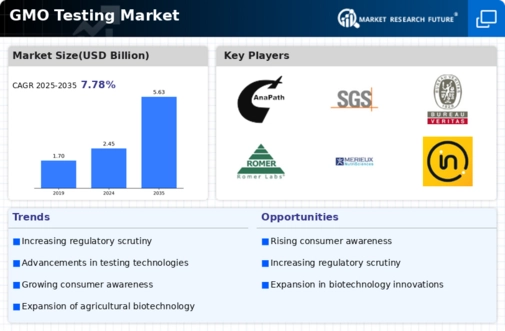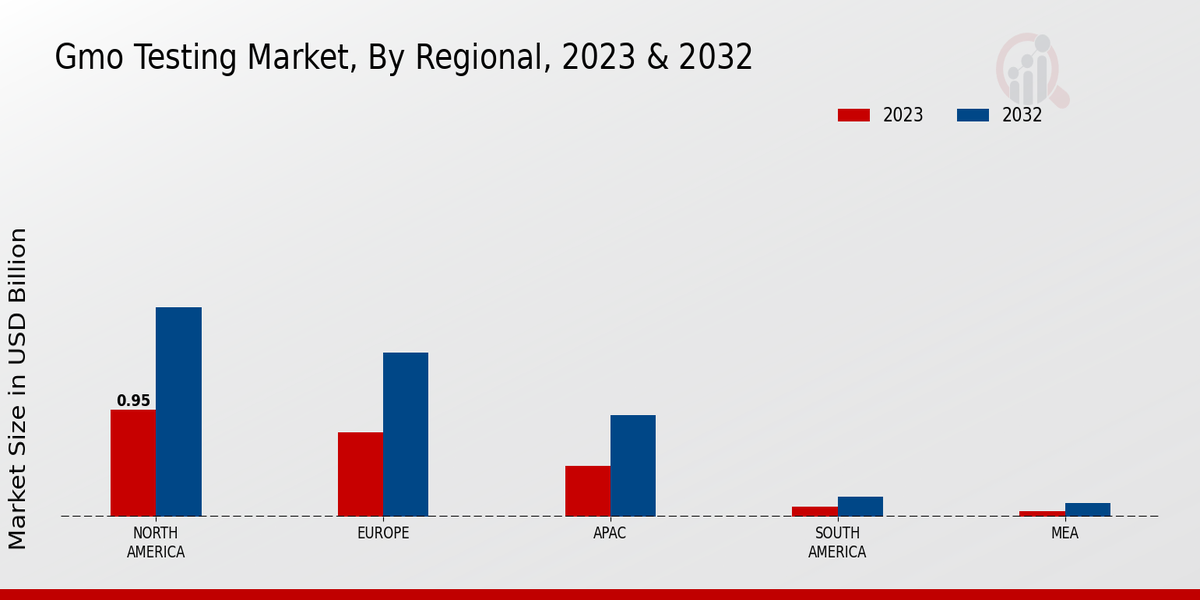Global Trade Dynamics
The dynamics of global trade are significantly impacting the Global GMO Testing Market Industry. As countries engage in international trade, the need for standardized testing protocols becomes paramount to ensure compliance with varying regulations. Importing nations often require rigorous testing of GMO content to protect local agriculture and consumer interests. This necessity drives demand for testing services, as exporters must demonstrate compliance with the importing country's standards. The interplay of trade agreements and regulatory frameworks is likely to propel the market forward, as businesses adapt to these complexities. Consequently, the Global GMO Testing Market is poised for growth as international trade continues to evolve.
Market Growth Projections
The Global GMO Testing Market Industry is projected to experience substantial growth over the next decade. With a market value of 2.45 USD Billion in 2024, it is anticipated to reach 5.63 USD Billion by 2035. This growth trajectory suggests a compound annual growth rate of 7.86% from 2025 to 2035. The increasing regulatory requirements, rising consumer awareness, and advancements in testing technologies are key factors driving this expansion. As the market evolves, stakeholders must remain vigilant to adapt to changing dynamics and capitalize on emerging opportunities within the GMO testing landscape.
Rising Consumer Awareness
Consumer awareness regarding the implications of GMOs is on the rise, significantly influencing the Global GMO Testing Market Industry. As individuals become more informed about the potential health and environmental impacts of genetically modified foods, there is a growing demand for transparency in food labeling. This trend is prompting food manufacturers and retailers to seek reliable testing services to verify the GMO content of their products. Consequently, the market is likely to expand as companies strive to meet consumer expectations for non-GMO products. The anticipated growth trajectory suggests that the Global GMO Testing Market could reach 5.63 USD Billion by 2035, driven by this increasing consumer demand.
Increasing Regulatory Requirements
The Global GMO Testing Market Industry is experiencing heightened scrutiny due to increasing regulatory requirements across various regions. Governments are implementing stringent guidelines to ensure food safety and environmental protection, which necessitates comprehensive testing of genetically modified organisms. For instance, the European Union has established rigorous protocols for GMO labeling and testing, compelling manufacturers to adopt advanced testing methodologies. This regulatory landscape is projected to drive the market's growth, as companies invest in compliance measures to meet these evolving standards. As a result, the Global GMO Testing Market is expected to reach 2.45 USD Billion in 2024, reflecting the industry's response to these regulatory pressures.
Emerging Markets and Agricultural Development
Emerging markets are becoming increasingly relevant in the Global GMO Testing Market Industry, particularly as agricultural development accelerates in these regions. Countries in Asia and Africa are adopting biotechnology to enhance crop yields and food security, leading to a rise in GMO cultivation. This trend necessitates robust testing frameworks to monitor and regulate GMO usage effectively. As these markets expand, the demand for testing services is expected to grow, driven by the need for compliance with international standards and consumer safety. The Global GMO Testing Market is likely to benefit from this agricultural shift, positioning itself for sustained growth in the coming years.
Technological Advancements in Testing Methods
Advancements in testing technologies are playing a crucial role in shaping the Global GMO Testing Market Industry. Innovations such as polymerase chain reaction (PCR) and next-generation sequencing (NGS) are enhancing the accuracy and efficiency of GMO detection. These technologies enable rapid testing and provide reliable results, which are essential for regulatory compliance and consumer assurance. As testing methods evolve, laboratories are better equipped to handle the growing volume of samples, thereby facilitating market growth. The integration of these advanced technologies is expected to contribute to a compound annual growth rate of 7.86% from 2025 to 2035, underscoring the importance of technological progress in this sector.





















